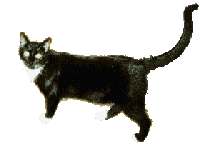




LA Animal Services
Pet of the Day
Adopt a pet today!
The Louisiana Department of Agriculture and Forestry, the Louisiana Society for the Prevention of Cruelty to Animals (LA/SPCA), the Louisiana Veterinary Medical Association (LVMA), the Louisiana Animal Control Association (LACA), the LSU AgCenter, and the LSU School of Veterinary Medicine (SVM) are working together to help pets and displaced animals from storm-ravaged areas of south Louisiana.
TAs of Saturday, September 10, 2005, the Parker Coliseum was housing almost 1,100 companion animals, including over 600 dogs, over 400 cats, and assorted pigs, rabbits, guinea pigs, ferrets, hamsters, gerbils, mice, and birds. Most of these pets are being cared for by volunteers; owners who are staying here in town are caring for 120 of the animals. Daily admission of animals is still exceeding the numbers being discharged to their owners, but people and their pets are being reunited every day.



Send letters for Mumia Abu-Jamal
update: Judge reverses Death Penalty decision and orders new sentencing hearing.
 Wallace's Clouds
Wallace's Clouds Collages
Collages
"As human beings, our greatness lies not so much in being able to remake
the world... as in being able to remake ourselves.
"Mahatma Gandhi, 1869-1948
Indian Political and Spiritual Leader
 Scientific Pantheism
Scientific Pantheism Chaos Theory
Chaos Theory
 Nature of the Universe Debate
Nature of the Universe Debate Thought Crime, visit
Thought Crime, visit  The Secular Web, or
The Secular Web, or  Earth Island Institute
Earth Island Institute
Easily found with the naked eye, 4th-magnitude Rho Cassiopeiae may be getting ready for an enormous mass ejection in the next few months.
New observations from the Japanese 8-m Subaru telescope and the ESO Very Large Telescope (VLT) have revealed new details in the Virgo galaxy cluster - located 50 million light years away. One insight is that massive young stars seem to be able to form in isolation, far away from the brighter parts of galaxies.
The Hubble Space Telescope has provided the clearest view of nearby Quasar 3C 273 ever taken in visible light. The image was taken by using the newly installed Advanced Camera for Surveys (ACS), which is able to block the brightest light to show the dimmer parts of the object. Features in the galaxy surrounding the central quasar are clearly visible.
Just in case you were worried, it appears that a supernova would have to be really really close to the Earth before it could cause massive damage to our environment. Scientists at NASA and Kansas University used data from a recent exploding star to determine that a supernova would have to be only 26 light-years away in order to strip away the ozone layer - an encounter that only happens once every 670 million years.
The most recent photos released from the Hubble Space Telescope show objects so old they might be from a time when stars in the universe were just starting to shine in significant numbers - about 13 billion years ago. These objects are at the limit of Hubble's resolving power, but the next generation James Webb Space Telescope is expected to see the entire group of proto-galaxies, and look back even further.
The Hubble Space Telescope has used a natural 2-million-light-year wide "zoom lens" to look further into space than it normally could. By peering directly through the centre of one of the most massive galactic clusters known, it was able to take advantage of a technique called gravitational lensing to see objects beyond the cluster. Detailed analysis of the image may help shed some light on the mystery of dark matter.
Using the Chandra X-Ray Observatory, astronomers have created one of the most vivid images of Sagittarius A, an area at the centre of our Milky Way galaxy thought to contain a supermassive black hole. The exposure was made over a period of two weeks, and during that time, the region flared up several times; presumably when additional material reached the black hole's event horizon.
A new paper published by Dartmouth university researcher Brian Chaboyer reports that our universe might be dominated by "dark energy"; a mysterious force that seems to be causing objects in the universe to accelerate away from each other. The researchers came to this conclusion by calculating the age of distant globular clusters, and matching it to the expansion age of the universe. The numbers only match if the universe has been accelerating up until now.
The highest resolution mid-infrared picture ever taken of the center of our Milky Way galaxy reveals details about dust swirling into the black hole that dominates the region.
An analysis of 13.5 thousand million-year-old X-rays, captured by ESA's XMM-Newton satellite, has shown that either the Universe may be older than astronomers had thought or that mysterious, undiscovered 'iron factories' litter the early Universe.

The newest image taken with the Chandra X-Ray Observatory is of distant supernova remnant SNR G54.1+0.3. The object contains a ring of high-energy particles which is created by a rapidly spinning central neutron star. Because it spins 7 times a second, the neutron star has created an enormous electric field which accelerates particles near the star and produces jets which blast away from the poles.
Astronomers from the National Science Foundation and Caltech have created the most detailed images ever made of the oldest light emitted by the Universe. The team used the Cosmic Background Imager, an array of sensitive microwave detectors in the Chilean desert, to gather light that had traveled 14 billion years to reach the Earth; it shows us the Universe at only 300,000 years old, just as seeds of matter had started to form, eventually becoming galaxies, stars, planets, and us.
23 May 2002 - The Very Small Array (VSA) and the Cosmic Background Imager (CBI) both released new high angular resolution data on the minute temperature differences around the sky in the 2.725 K blackbody radiation left over from the Big Bang. The 24 May 2002 New York Times reported the CBI results under the headline: "Scientists Develop the Universe's Baby Pictures" which is a pretty good description of these results. [ CNN coverage of CBI, BBC coverage of VSA,VSA on the Astronomy Picture of the Day].
24 Apr 2002 - The Hubble Space Telescope has measured the ages of white dwarfs in the globular cluster M4. The oldest white dwarfs are 12.7 +/- 0.7 billion years old in this cluster, so the Universe is 13-14 billion years old. The technical paper by Brad Hansen of UCLA and others is available here.
|
Sign
My Guestbook
![]() View
My Guestbook
View
My Guestbook



Congress shall make no law respecting an establishment of religion, or prohibiting the free exercise thereof; or abridging the freedom of speech, or of the press; or the right of the people to peaceably assemble, and to petition the Government for a redress of grievances.


